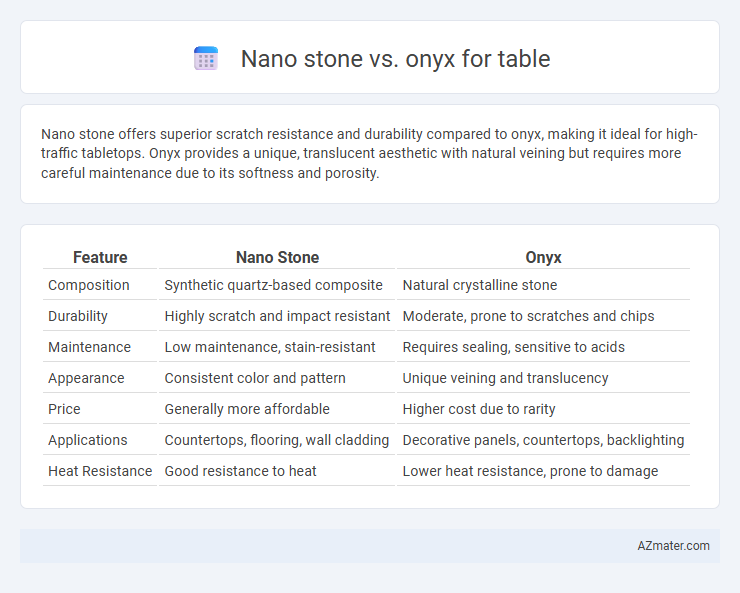Nano stone offers superior scratch resistance and durability compared to onyx, making it ideal for high-traffic tabletops. Onyx provides a unique, translucent aesthetic with natural veining but requires more careful maintenance due to its softness and porosity.
Table of Comparison
| Feature | Nano Stone | Onyx |
|---|---|---|
| Composition | Synthetic quartz-based composite | Natural crystalline stone |
| Durability | Highly scratch and impact resistant | Moderate, prone to scratches and chips |
| Maintenance | Low maintenance, stain-resistant | Requires sealing, sensitive to acids |
| Appearance | Consistent color and pattern | Unique veining and translucency |
| Price | Generally more affordable | Higher cost due to rarity |
| Applications | Countertops, flooring, wall cladding | Decorative panels, countertops, backlighting |
| Heat Resistance | Good resistance to heat | Lower heat resistance, prone to damage |
Introduction: Nano Stone vs Onyx for Tables
Nano stone offers superior durability and scratch resistance compared to onyx, making it ideal for high-traffic table surfaces. Onyx tables provide a unique, translucent appearance with natural veining, enhancing aesthetic appeal but requiring careful maintenance. Selecting between nano stone and onyx depends on balancing durability needs with visual elegance for table design.
Composition and Material Properties
Nano stone is a composite material made from a blend of natural quartz, resin, and pigments, offering high durability, scratch resistance, and low porosity, making it ideal for tabletops requiring robust surface strength. Onyx, a natural stone primarily composed of calcite and aragonite, features a translucent, luxurious appearance but is softer and more prone to scratching and staining compared to engineered nano stone. The dense and non-porous nature of nano stone provides superior resistance to heat and chemicals, whereas onyx demands careful maintenance to preserve its aesthetic and structural integrity in table applications.
Aesthetic Appeal: Colors and Patterns
Nano stone offers a sleek, contemporary aesthetic with a wide range of consistent colors and subtle, uniform patterns ideal for minimalist and modern table designs. Onyx captivates with its dramatic translucency and unique, swirling veins in vibrant hues, creating a luxurious and eye-catching table centerpiece. Both materials enhance tables with distinctive visual textures, but nano stone emphasizes durability and uniformity while onyx prioritizes bold, natural beauty.
Durability and Strength
Nano stone offers superior durability and resistance to scratches, stains, and heat, making it highly suitable for table surfaces subjected to heavy use. Onyx, while visually striking with its translucent appearance, is softer and more prone to etching, chipping, and damage from impact. For long-lasting strength in tables, nano stone provides a more resilient and maintenance-friendly option compared to the delicate nature of onyx.
Maintenance and Cleaning
Nano stone tables offer superior durability and stain resistance, requiring minimal maintenance with just regular wiping using a damp cloth and mild detergent. Onyx tables, while visually striking, demand more careful cleaning to avoid scratches and etching, needing non-abrasive cleaners and prompt spill removal to maintain their polished surface. Both materials benefit from routine sealing, but onyx surfaces typically require more frequent sealing to preserve their aesthetic and structural integrity.
Price Comparison
Nano stone tables typically cost between $50 to $150 per square foot, offering a budget-friendly option with high durability and stain resistance. Onyx tables are significantly more expensive, ranging from $100 to $300 per square foot due to the rarity and unique translucency of onyx material. Choosing between nano stone and onyx depends on balancing the desired aesthetic appeal with budget constraints, where nano stone provides cost-effective resilience and onyx delivers luxury and exclusivity.
Environmental Impact and Sustainability
Nano stone offers superior sustainability compared to onyx due to its eco-friendly manufacturing processes that reduce waste and energy consumption. Onyx, being a natural stone, requires extensive quarrying which can lead to significant habitat disruption and higher carbon emissions. The durability and low maintenance of nano stone also contribute to its environmental benefits by extending the table's lifespan and minimizing resource use.
Best Uses and Applications
Nano stone offers exceptional durability and stain resistance, making it ideal for high-traffic tabletops in kitchens and dining areas. Onyx, known for its stunning translucency and unique veining, suits luxury environments like conference room tables or decorative accent pieces where aesthetics are paramount. Nano stone excels in everyday practicality, while onyx provides a visually striking statement in sophisticated interior designs.
Pros and Cons of Nano Stone Tables
Nano stone tables offer exceptional durability, scratch resistance, and low porosity, making them highly resistant to stains and bacteria. Their lightweight nature and modern aesthetic appeal provide versatility in interior design, but they can be more expensive than onyx tables and lack the unique translucency and natural patterns of onyx. Maintenance of nano stone is generally easier, but it may not achieve the same luxurious, warm ambiance as an onyx surface.
Pros and Cons of Onyx Tables
Onyx tables offer a striking, natural translucency that creates a unique, luxurious aesthetic, ideal for sophisticated interior designs. However, onyx is softer and more porous than nano stone, making it prone to scratches, stains, and etching from acids, thus requiring careful maintenance and sealing. Despite its fragility, onyx's rich veining and warm glow provide an unmatched elegance not easily replicated by durable, but less visually dynamic, nano stone surfaces.

Infographic: Nano stone vs Onyx for Table
 azmater.com
azmater.com